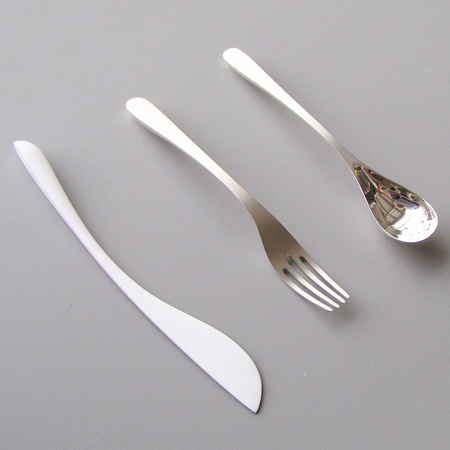
Shape/Form by Lukas Peet
Canadian designer Lukas Peet has created a set of cutlery comprising a silver fork and spoon and a ceramic knife.
Called Shape/Form, the objects are perceived by Preet as three-dimensional shapes hanging below the graphic silhouettes of the top surfaces.
Peet developed the forms by carving and shaping blocks of wood.
Here's some more information from Peet:
--
Thoughts:
I feel the ability to shape and form is very important as a designer. With the creation of numerous models I worked in an intuitive way directly with wood. Starting from rough sketches on the material as a judge for proportion, and the feel of shaping with my hands and eyes.
Each model (see website) was an evolution toward the “goal” of a set of cutlery that embodied my thoughts and feeling about shape and form, with each successive piece refining my senses, skills, as well as my understanding of what I found Interesting.
I feel the art of craft is disappearing, as designing is shifting to the computer, where I feel the personality and individuality is lost. I wanted to create an object by translating my ideas of Shape/Form to the object through the use of only my hands and eyes.
The result is a personal study of my ideas about shape and form. Applied to cultery as i find it interesting that it is a tool (shape), as well as an extension of the body (form) and how this is translated to an object.
Above photo is by Rene van der Hulst
Concept:
A set of cutlery that embodies my personal conclusions of shape and form. Where the graphical two dimensional shape of the top surface, allows the fluid three dimensional form to hang from. While contrasting each other, ultimately finding a complimenting balance as they influence one another.
Finished in Technical Ceramic and silver, they relate to traditional table ware. (Silverware and Fine China)
Some Quotes that I feel apply and support my work and thoughts:
“As the work interacts with the body of the observer, the experience mirrors the bodily sensations of the maker. Consequently, comuntiacting the body of the maker directly to the body of the person who encounters the work.” - Juhani Pallasmaa
“The hand’s essence can never be determined, or explained, by its being an oragn which can grasp [...] Every motion of the hand in every one of its works carries itself through the element of thinking, every bearing of the hand bears itself in that element.” - Heidegger
“The hands are the sculptor’s eyes; but they are also organs for thought” - Auguste Rodin